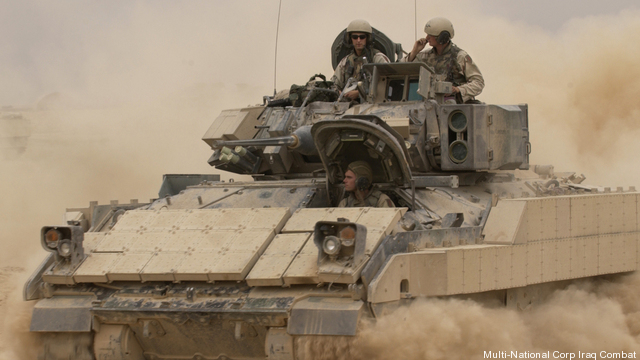Smart Weapons Spread Undercuts Need For Army Combat Vehicle
Posted on

Since 911, the U.S. military has invested huge amounts of money in protecting troops, buying add-on armor kits for everything from the humble Humvee to the massive M1 tank. But the spread of smart weapons to Third World forces, both rogue states and guerrillas, may be outpacing the Pentagon’s ability to counter them, warns a new report from top thinktank analyst Andrew Krepinevich.
“The experience in Afghanistan and Iraq suggests that anti-armor weapons will be cheaper and faster to field [than upgraded armor protection],” Krepinevich told reporters gathered at the thinktank he heads, the Center for Strategic and Budgetary Assessments. “That’s not a game you want to be in if you’re in an age of austerity, so that creates a real problem for the Army and Marine Corps” – particularly, he said, for programs like the Army’s Ground Combat Vehicle.
America launched the precision-guidance revolution and leads it, but the technology is spreading. “The problem for the United States is we’ve had a near monopoly in this kind of warfare for the last twenty years, and now the Chinese are clearly beginning to catch up, the Iranians are sort of [as well],” Krepinevich said. “Even a little bit can mean a lot,” he added, noting that the much-publicized smart weapons of the 1991 Gulf War represented less than 7 percent of U.S. munitions at the time.
So a relatively small transfer of technology from a state sponsor to an irregular proxy force –- what analysts often call a “hybrid” threat – could have a strategic impact. High-powered roadside bombs provided by Iran — deadly “explosively formed penetrators” — became the bane of U.S. forces during the surge Baghdad. Or consider the 2006 war between Israel and the Iranian-backed Lebanese group Hezbollah, he said: “If 10 percent of the 4,000 projectiles they fired against Israel were guided, the character of that war would change dramatically.”
So what are the implications for American military modernization? The U.S. has spent over $60 billion on MRAPs and on countermeasures against improvised explosive devices; there are no figures for insurgent spending on bigger roadside bombs, but it must have been much less. It’s an arms race where a relatively impoverished enemy can outspend the U.S., because what they’re trying to do is so much easier, but, “It’s not clear that the united States Army and Marine Corps can get out of the box,” said Krepinevich. “There’s a moral imperative… [and] in a volunteer force, this is kind of a job environment issue.”
What Krepinevich advises is to spend modestly on upgrades to existing vehicles and hold off on big investments in new designs until new protective technologies emerge – which could be a while. That approach would spell particular trouble for the Army’s Ground Combat Vehicle, an expensive effort to make a better-protected troop carrier with existing technology that can replace the aging M2 Bradley.
It’s not that GCV is too ambitious, Krepinevich said, contrasting it to its cancelled predecessor, the Future Combat Systems. “If they can fund it adequately, then I think that the probability that they’ll come up with something they can field and be comfortable with is significantly greater than FCS,” he said. “[But] the point we’re making here is, absent some major technological advance that really helps you to be dramatically more effective… you’re better off not pouring a lot of money into development to get a marginally better product at the end.” Instead, Krepinevich argues for investing in long-term research in the hopes that some new innovation will restore the balance between what we can do to protect our troops and what adversaries can do to kill them.
Subscribe to our newsletter
Promotions, new products and sales. Directly to your inbox.
